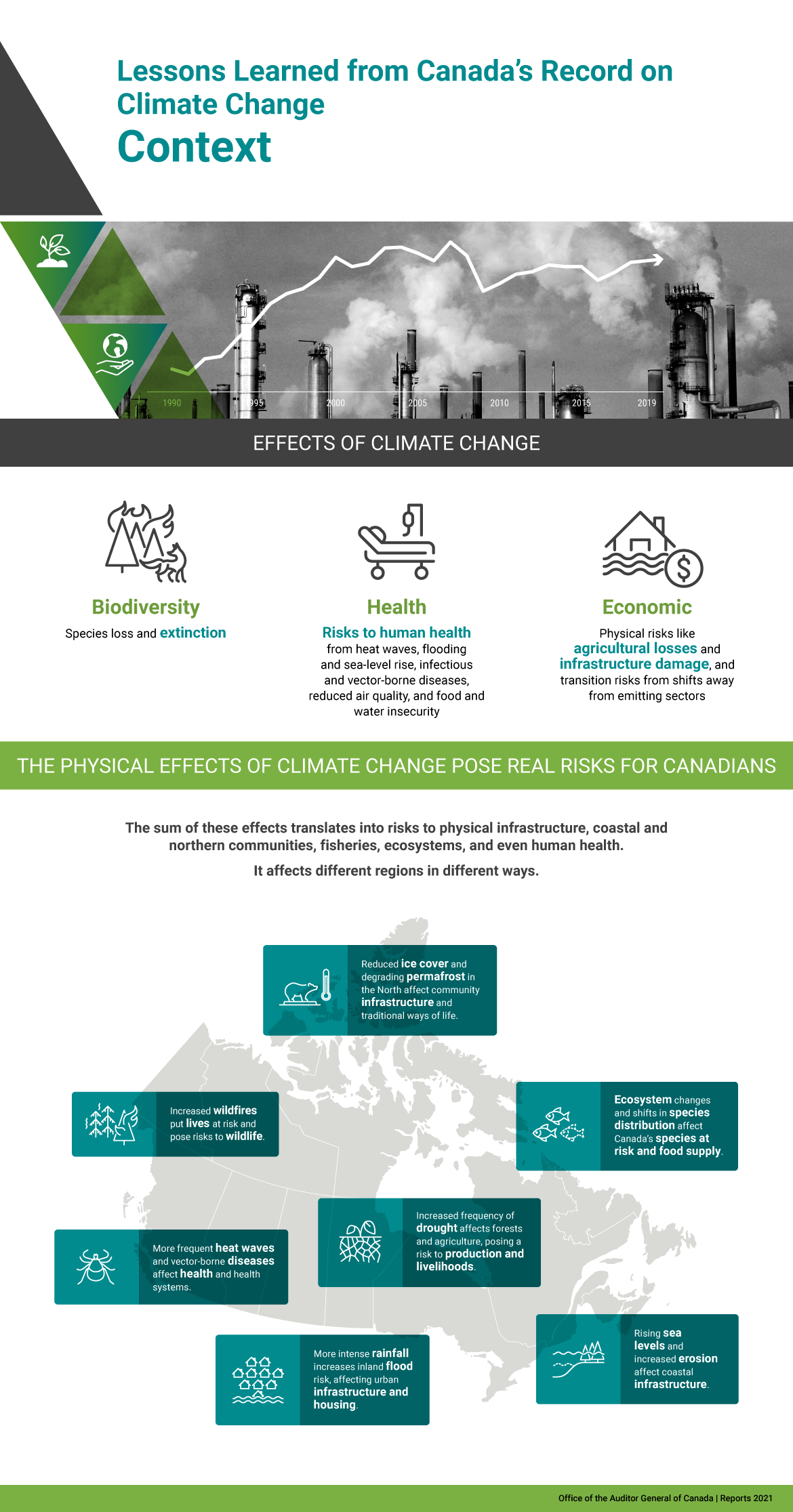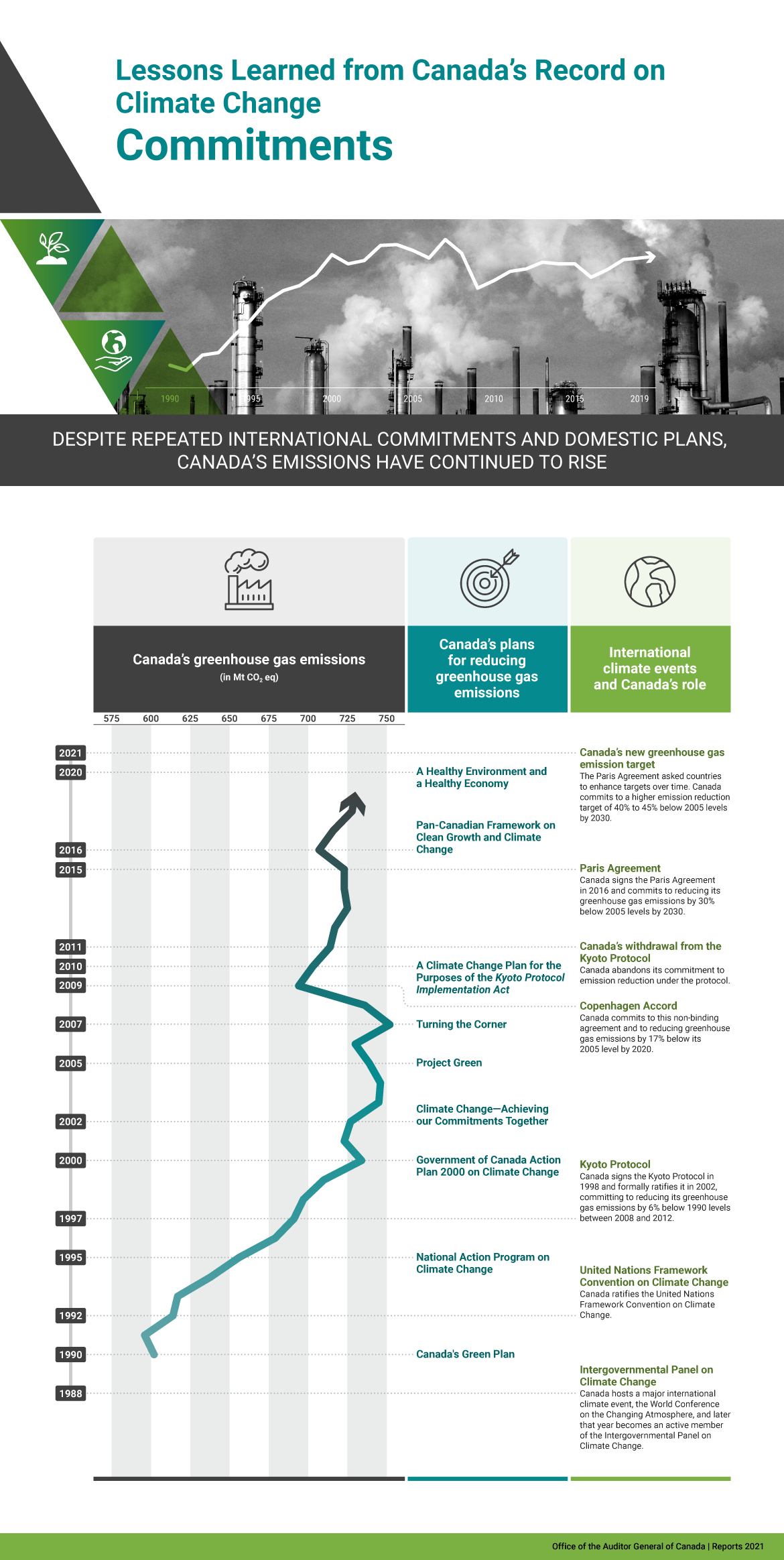Lessons Learned from Canada’s Record on Climate Change—Infographics

Text version
This infographic outlines the effects of climate change in Canada.
Effects of climate change
Climate change affects biodiversity by causing species loss and extinction.
Climate change affects health. It creates risks to human health from heat waves, flooding and sea-level rise, infectious and vector-borne diseases, reduced air quality, and food and water insecurity.
Climate change affects the economy. It creates physical risks like agricultural losses and infrastructure damage, and transition risks from shifts away from emitting sectors.
The physical effects of climate change pose real risks for Canadians
The sum of these effects translates into risks to physical infrastructure, coastal, and northern communities, fisheries, ecosystems, and even human health.
It affects different regions in different ways:
- Reduced ice cover and degrading permafrost in the North affect community infrastructure and traditional ways of life.
- Increased wildfires put lives at risk and pose risks to wildlife.
- Ecosystem changes and shifts in species distribution affect Canada’s species at risk and food supply.
- More frequent heat waves and vector-borne diseases affect health and health systems.
- Increased frequency of drought affects forests and agriculture, posing a risk to production and livelihoods.
- More intense rainfall increases inland flood risk, affecting urban infrastructure and housing.
- Rising sea levels and increased erosion affect coastal infrastructure.

Text version
This infographic shows Canada’s greenhouse gas emissions in megatonnes of carbon dioxide equivalent from 1990 to 2019 and its plans for reducing emissions during that period. The infographic also shows when the Government of Canada participated in major international climate agreements from 1988 to 2021.
Overall message from our 2021 report
Despite repeated international commitments and domestic plans, Canada’s emissions have continued to rise.
Timeline
1988—Canada hosts a major international climate event, the World Conference on the Changing Atmosphere, and later that year becomes an active member of the Intergovernmental Panel on Climate Change.
1990—The government releases Canada’s Green Plan. Canada’s overall emissions are 602 megatonnes.
1992—Canada ratifies the United Nations Framework Convention on Climate Change. Canada’s overall emissions have risen to 614 megatonnes.
1995—The government releases the National Action Program on Climate Change. Canada’s overall emissions have risen to 656 megatonnes.
1997—The Kyoto Protocol is adopted. Canada signs the Kyoto Protocol in 1998 and formally ratifies the agreement in 2002, committing to reducing its greenhouse gas emissions by 6% below 1990 levels between 2008 and 2012. Canada’s overall emissions have risen to 691 megatonnes.
2000—The government releases the Government of Canada Action Plan 2000 on Climate Change. Canada’s overall emissions have risen to 734 megatonnes.
2002—The government releases Climate Change—Achieving Our Commitments Together. Canada’s overall emissions have fallen to 727 megatonnes.
2005—The government releases Project Green. Canada’s overall emissions have risen to 739 megatonnes.
2007—The government releases Turning the Corner. Canada’s overall emissions have risen 752 megatonnes.
2009—Canada commits to the Copenhagen Accord, a non-binding agreement, and to reducing its greenhouse gas emissions by 17% below 2005 levels by 2020. Canada’s overall emissions have fallen to 694 megatonnes.
2010—The government releases A Climate Change Plan for the Purposes of the Kyoto Protocol Implementation Act. Canada’s overall emissions have fallen to 703 megatonnes.
2011—Canada withdraws from the Kyoto Protocol and abandons its commitment to emission reduction under the protocol. Canada’s overall emissions have risen to 714 megatonnes.
2015—The Paris Agreement is adopted. Canada signs the Paris Agreement in 2016 and commits to reducing its greenhouse gas emissions by 30% below 2005 levels by 2030. Canada’s overall emissions have risen to 723 megatonnes.
2016—The government releases the Pan-Canadian Framework on Clean Growth and Climate Change. Canada’s overall emissions have fallen to 707 megatonnes.
2020—The government releases A Healthy Environment and a Healthy Economy. The year before, Canada’s emissions had risen 730 megatonnes.
2021—The Paris Agreement asked countries to enhance targets over time. Canada commits to a higher emission reduction target of 40% to 45% below 2005 levels by 2030, which equates to annual emissions of about 406 to 443 megatonnes of carbon dioxide equivalent.
